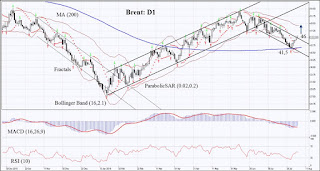US stocks rose on Monday as investors adjust expectations for a rate hike this year. The dollar strengthened slightly: the live dollar index data indicate the ICE US Dollar Index, a measure of the dollar’s value against a basket of six major currencies, edged up 0.06% to 95.543. The Dow Jones industrial average closed 0.6% higher at 18502.99 led by Dupont,Travelers, American Express and JP Morgan shares, each up more than 1%. The S&P 500 ended 0.5% higher at 2180.38 led by 1% gain in energy stocks. The Nasdaq composite added 0.3% settling at 5232.33. Banking stocks rose on higher likelihood of a rate hike after Federal Reserve Chair Janet Yellen’s speech and Vice Chairman Fischer's comments at Jackson Hole, Wyoming. Yellen said on Friday an improving US economy had strengthened the case for a rate increase, with Fischer echoing by a bullish comment that Yellen’s speech was “consistent” with possibly two rate increases this year. Banking stocks tend to rise in higher rate environment on improved earnings prospects as the difference between rates they earn on loans and interest they pay out on deposits, known as net interest margins, rises when rates rise. The Fed funds futures market is now pricing in a nearly 50% chance of at least one hike by the end of 2016. In economic news the Personal Spending growth in July slowed to 0.3% from 0.5% in June while Personal Income Rose to 0.4% from 0.3%, in line with expectations. Inflation was unchanged in July with the PCE index, the Federal Reserve’s preferred inflation gauge, increasing 0.8% in the 12 months ended in July against 0.8% in June, while the annual rate of core PCE inflation was flat at 1.6% below the Fed’s 2% target. Today at 15:00 CET S&P/Case-Shiller Home Price Index for June will be released. The tentative outlook is negative for dollar. At 16:00 CET Conference Board Consumer Confidence for August will be published, the outlook is negative.
European stocks closed lower on Monday with expected tightening of US monetary policy weighing on market indexes. The euro and Pound ended lower against the dollar. The Stoxx Europe 600 closed 0.2% lower. Shares of oil companies slid as oil prices fell: Repsol dropped 1.3%, Eni lost 1% and Total was 0.9% lower. Germany’s DAX 30 lost 0.4% settling at 10544.44, France’s CAC 40 also closed down 0.4% at 4424.25. UK markets were closed for a local bank holiday. Today at 14:00 CET preliminary August consumer price index will be released in Germany, the outlook is negative for euro.
Asian stocks are rising today with Chinese stocks following banking stocks’ lead ahead of earnings reports from major banks: Shanghai Composite Index is 0.2% higher and Hong Kong’s Hang Seng index is 1% up, while Australia’s All Ordinaries Index gained 0.2%. Nikkei ended 0.07% lower today at 16725.36 as the pace of yen weakening against the dollar slowed after sharp yen depreciation on Friday follwoing Fed Chair Yellen’s speech. Market reaction to better than expected unemployment and retail sales reports was muted.
Oil futures prices are extending losses today on lower expectations that major crude producers may come to an agreement to freeze output at a meeting in late September. October Brent crude fell 1.3% to $49.26 a barrel on London’s ICE Futures exchange on Monday.













